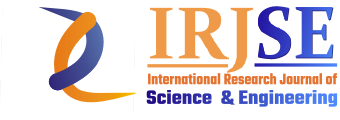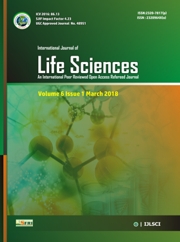RESEARCH ARTICLES
Volume 8 |Issue 2| March-April 2020 First published: 9 April 2020
SARS COV 2 Identity matrix
Rithu BS
Department of Biotechnology, RV College of Engineering, Bangalore, Karnataka, India
Abstract
Keywords:SARS COV 2, multiple sequence alignment, N gene, S gene & RdRP gene.
Editor: Dr.Arvind Chavhan
Cite this article as:
Rithu BS. SARS COV 2 Identity matrix, Int. Res. Journal of Science & Engineering, 2020. Volume 8 (2) : 41-57.
References
1. uang C et al, 2020. Clinical features of patients infected with 2019 novel coronavirus in Wuhan, China. Lancet 395:497–506. doi:10.1016/S0140-6736(20)30183-5
2. Rodriguez-Morales AJ et al, 2020. Going global: travel and the 2019 novel coronavirus. Travel Med Infect Dis 33:101578. doi:10.1016/j.tmaid.2020.101578.
3. Rodriguez-Morales AJ et al , 2020. History is repeating itself, a probable zoonotic spillover as a cause of an epidemic: the case of 2019 novel coronavirus. Infez Med 28:3–5
4. Rodriguez-Morales AJ et al, 2020. History is repeating itself, a probable zoonotic spillover as a cause of an epidemic: the case of 2019 novel coronavirus. Infez Med 28:3–5
5. Chu DK et al, 2020. Molecular diagnosis of a novel coronavirus (2019-nCoV) causing an outbreak of pneumonia. Clin Chem. doi:10.1093/clinchem/hvaa029.
6. Snijder E.J., Bredenbeek P.J., Dobbe J.C., Thiel V., Ziebuhr J., Poon L.L., Guan Y., Rozanov M., Spaan W.J., Gorbalenya A.E. Unique and conserved features of genome and proteome of SARS-coronavirus, an early splitoff from the coronavirus group 2 lineage. J. Mol. Biol. 2003;331:991–1004. doi: 10.1016/S0022-2836(03)00865-9.
7. Thiel V., Ivanov K.A., Putics A., Hertzig T., Schelle B., Bayer S., Weissbrich B., Snijder E.J., Rabenau H., Doerr H.W., et al. Mechanisms and enzymes involved in SARS coronavirus genome expression. J. Gen. Virol. 2003;84 Pt 9:2305–2315.
8. Laude H., Masters P. Coronaviruses and Arteriviruses. Plenum Press; New York, NY, USA: 1995. The coronavirus nucleocapsid protein; pp. 141–163.
9. Parker M.M., Masters P.S. Sequence comparison of the N genes of five strains of the coronavirus mouse hepatitis virus suggests a three domain structure for the nucleocapsid protein. Virology. 1990;179:463–468.
10. Huang Q., Yu L., Petros A.M., Gunasekera A., Liu Z., Xu N., Hajduk P., Mack J., Fesik S.W., Olejniczak E.T. Structure of the N-terminal RNA-binding domain of the SARS CoV nucleocapsid protein. Biochemistry. 2004;43:6059–6063.
11. Raj VS, Mou H, Smits SL, Dekkers DH, Muller MA, Dijkman R, Muth D, Demmers JA, Zaki A, Fouchier RA, Thiel V, Drosten C, Rottier PJ, et al. Dipeptidyl peptidase 4 is a functional receptor for the emerging human coronavirus-EMC. Nature. 2013;495:251–4.
12. Lu G, Hu Y, Wang Q, Qi J, Gao F, Li Y, Zhang Y, Zhang W, Yuan Y, Bao J, Zhang B, Shi Y, Yan J, et al. Molecular basis of binding between novel human coronavirus MERS-CoV and its receptor CD26. Nature. 2013;500:227–31.
13. Mou H, Raj VS, van Kuppeveld FJ, Rottier PJ, Haagmans BL, Bosch BJ. The receptor binding domain of the new Middle East respiratory syndrome coronavirus maps to a 231-residue region in the spike protein that efficiently elicits neutralizing antibodies. J Virol. 2013;87:9379–83.
14. Lu L, Liu Q, Zhu Y, Chan KH, Qin L, Li Y, Wang Q, Chan JF, Du L, Yu F, Ma C, Ye S, Yuen KY, et al. Structure-based discovery of Middle East respiratory syndrome coronavirus fusion inhibitor. Nat Commun. 2014;5:3067.
15. Elena S.F., Sanjuan R. Adaptive value of high mutation rates of RNA viruses: Separating causes from consequences. J. Virol. 2005;79:11555–11558. doi: 10.1128/JVI.79.18.11555-11558.2005.
16. Crotty S., Cameron C.E., Andino R. RNA virus error catastrophe: Direct molecular test by using ribavirin. Proc. Natl. Acad. Sci. USA. 2001;98:6895–6900.
17. Lai M.M. Cellular factors in the transcription and replication of viral RNA genomes: A parallel to DNAdependent RNA transcription. Virology. 1998;244:1–12.
18. Baer CF. Does mutation rate depend on itself. PLoS Biol. 2008;6(2):e52 10.1371/journal.pbio.0060052
19. Loewe L, Hill WG. The populations of mutations: good, bad and indifferent. Philosophical transactions of the Royal Society of London. 2010;365(1544):1153–67.
20. Gago S, Elena SF, Flores R, Sanjuan R. Extremely high mutation rate of a hammerhead viroid. Science. 2009;323(5919):1308 10.1126/science.1169202 .

